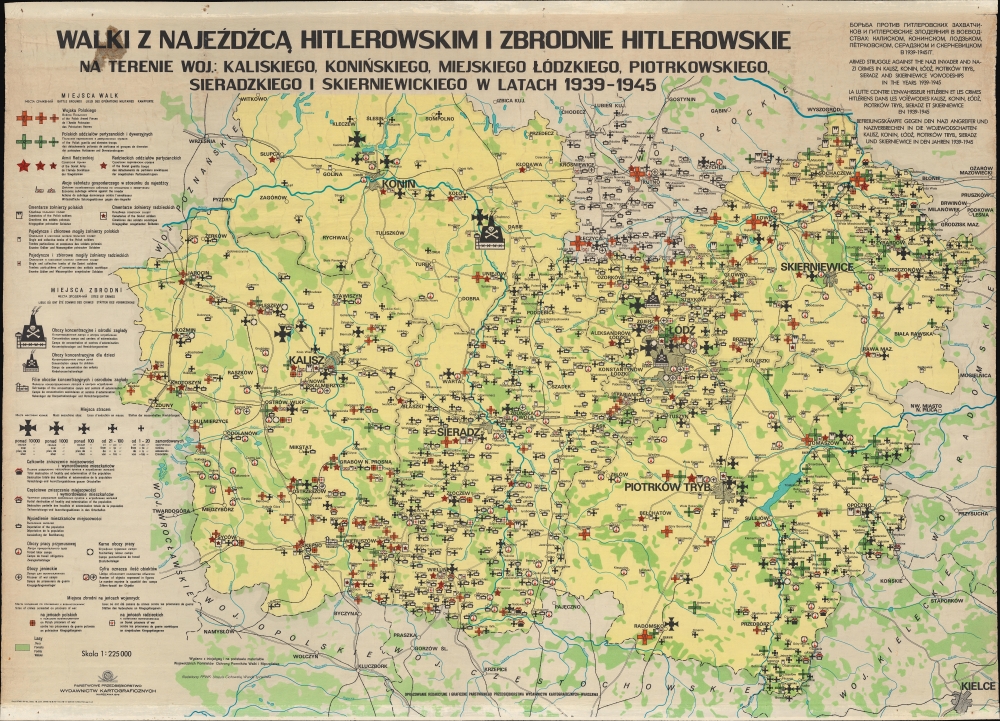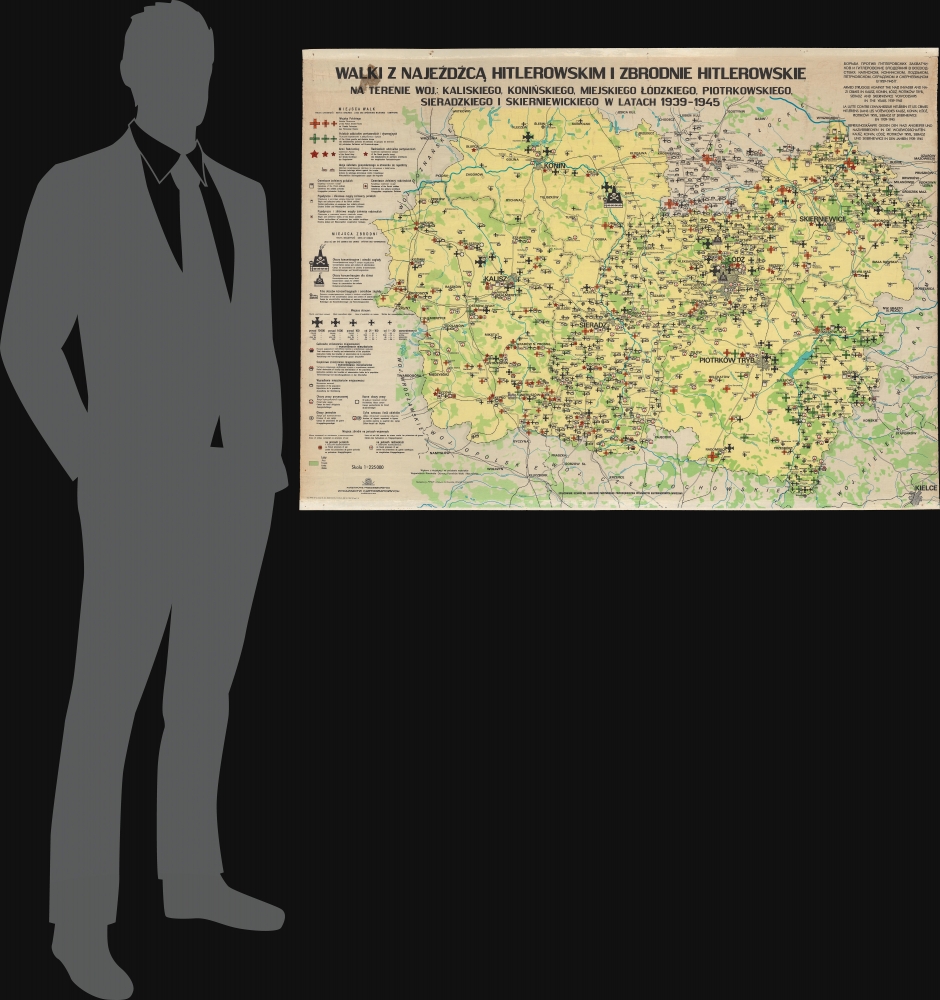1979 Polish Multilingual Map of Nazi Crimes around Konin, Łódź, and Kalisz, Poland
KaliskiegoKoninskiego-walki-1979$4,000.00

Title
Walki z Najeźdźcą Hitlerowskim i Zbrodnie Hitlerowskie na Terenie Woj.: Kaliskiego, Konińskiego, Miejskiego Łódzkiego, Piotrkowskiego, Sieradzkiego i Skierniewickiego w Latach 1939 - 1945. / Armed Struggle Against the Nazi Invader and Nazi Crimes in Kalisz, Konin, Łódź, Poitrków Tryb., Sieradz and Skierniewice Voivodeships in the Years 1939 - 1945.
1979 (dated) 34.5 x 48.5 in (87.63 x 123.19 cm) 1 : 225000
1979 (dated) 34.5 x 48.5 in (87.63 x 123.19 cm) 1 : 225000
Description
A chilling 1971 wall map detailing Hitler's crimes and the fight against the Nazi invasion and occupation in the voivodeships of Kalisz, Konin, Łódź, Piotrków Tryb., Sieradz and Skierniewice in central Poland. It was published by the Provincial Committees for the Protection of Monuments to Struggle and Martyrdom. It is ever more poignant in the light of modern revisionist historical research that has re-evaluated the Polish role in the Holocaust, as well as efforts by the current Polish government to legislate and control the historical record. All text on this piece is in Polish, Russian, English, French, and German.The map depicts the 6 voivodeships east of Warsaw. Icons detail Nazi crimes. The largest marks Chełmno, the first Nazi extermination camp. Two others mark concentration camps for children. Black Iron Crosses mark mass execution sites, with the size of the cross corresponding to the magnitude of the massacre. The largest crosses, such as those in Łódź and near Kazimierz Bisk and Gołuchów, symbolize massacres of over 10,000 individuals. Corresponding symbols mark towns that were destroyed and their populace exterminated, towns that were partially destroyed and exterminated, and towns where the population was deported. Small red shovels surrounded by barbed wire identify forced labor camps. Symbols also mark prisoner-of-war camps and sites of crimes committed against Polish and Soviet Prisoners of War.
This derives from the necessity of kowtowing to Soviet censorship. Although the Nazis and Hitler are demonized, there is no clear anti-German bias. The map appears to have been produced from impartial sources to represent Nazi war crimes accurately. Through this and similar maps, much of the current leadership of Poland, who grew up in the Soviet Era, received their education and understanding of the Holocaust.
Today, historical revisionism regarding Poland's role in the Holocaust encompasses a contentious area of public discourse. The narrative traditionally highlights Poland as a nation under German occupation, with Poles risking their lives to help Jews. This happened. However, current scholars are bringing to light other instances where some Poles collaborated with Nazis or participated in the persecution of Jews. This revisionism has sparked intense debate, influenced by broader considerations of national identity, memory, and responsibility. Current efforts by the Polish government to legislate how the Holocaust is remembered, particularly laws making it illegal to accuse the Polish nation of complicity in the Holocaust, have further intensified these debates, highlighting the ongoing struggle over the historical record.
Fighting the Invasion and Occupation
The other symbols present highlight actions taken against the Nazis. Orange crosses mark the battlegrounds of the Polish Armed Forces, while green crosses mark the battle sites of Polish guerrilla forces. Red stars mark Red Army and Soviet guerrilla battle sites. Small symbols with red 'x's highlight locations of sabotage actions against the Nazis. Other symbols mark cemeteries and graves for Polish, Soviet, British, French, and International forces buried in Poland.Through a Soviet Lens
When this map was issued, Poland was firmly part of the Soviet Eastern Bloc. While the map is sensitive to the plight of Poles in general and especially the Soviets who suffered under the Nazis, this map is representative of the Soviet party line regarding 'Hitler's atrocities' - that all nations suffered, fought, and won equally. Aside from the Soviets and Poles, there is no mention of any specific ethnic or religious group. There also is naturally no mention of the Soviet Union's repressive actions and war crimes against Poles.This derives from the necessity of kowtowing to Soviet censorship. Although the Nazis and Hitler are demonized, there is no clear anti-German bias. The map appears to have been produced from impartial sources to represent Nazi war crimes accurately. Through this and similar maps, much of the current leadership of Poland, who grew up in the Soviet Era, received their education and understanding of the Holocaust.
Today, historical revisionism regarding Poland's role in the Holocaust encompasses a contentious area of public discourse. The narrative traditionally highlights Poland as a nation under German occupation, with Poles risking their lives to help Jews. This happened. However, current scholars are bringing to light other instances where some Poles collaborated with Nazis or participated in the persecution of Jews. This revisionism has sparked intense debate, influenced by broader considerations of national identity, memory, and responsibility. Current efforts by the Polish government to legislate how the Holocaust is remembered, particularly laws making it illegal to accuse the Polish nation of complicity in the Holocaust, have further intensified these debates, highlighting the ongoing struggle over the historical record.
Publication History and Census
This map was edited by Urszula Cichowska and Wanda Łyżwińska and published by the Provincial Committees for the Protection of Monuments to Struggle and Martyrdom (Wojewódzkich Komitetów Ochrony Pomników Walki i Męczeństwa). We note a single cataloged example, located at the National Library of Poland, Biblioteka Nardowa.Condition
Very good. Mounted on linen. Some soiling. Wear along edges.
References
OCLC 947763236.




